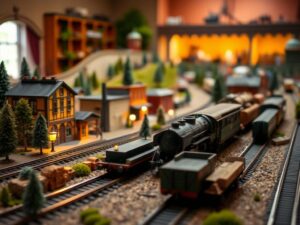How to Plan HO Scale Layouts for Operational Realism
How to Plan HO Scale Layouts for Operational Realism
How to Plan Realistic HO Scale Layouts for Operational Realism
Welcome aboard fellow railroad enthusiasts! Today we’re diving deep into the exciting world of planning realistic HO scale layouts â specifically focusing on operational realism, that magic ingredient that brings your miniature railway world to life. Whether you’re a complete newbie or a seasoned modeler looking to spice up your current setup, this guide will provide valuable insights and technical tips to help you build a layout that truly runs like the real thing.
Why Operational Realism Matters
Operational realism goes beyond simply having pretty trains chugging around. Itâs about crafting a railway system that reflects the complexity and dynamics of real-world rail networks. Imagine bustling industries, scheduled freight movements, passenger trips, switching operations â a dynamic symphony of rail activity orchestrated within your own living room!
Here’s why striving for operational realism elevates your modeling experience:
- Enhances Storytelling: A realistically functioning layout tells a compelling story about the railway industry and its communities.
- Boosts Engagement: Watching trains work, move freight, and interact with industries keeps you immersed in the hobby and constantly eager to see what unfolds next.
- Sharpen Your Skills: Planning for realistic operations demands an understanding of traffic flow, timetables, signaling, and track design â all elements that significantly refine your modeling knowledge.
- Community Connection: Operational model railroading is a fantastic way to connect with fellow enthusiasts, share your work, and learn from each other’s unique setups and challenges.
The Core Principles: Foundations of Realistic Operations
Building an operationally realistic layout isn’t just about the physical track; it requires understanding how real railroads function at their core:
- Traffic Flows: Analyze what types of trains would typically operate on your chosen prototype railroad (e.g., passenger, freight) and design your layout to accommodate their respective requirements (track lengths, passing sidings).
-
Yard and Switching Operations: Include a well-planned yard with industries and spurs for switching tasks â a crucial element that introduces dynamism and complexity to your layout. Freight cars need to be sorted, coupled together, and transferred between industries â mimicking real-world railway workflows.
-
Staging Yard: Implement a hidden staging area off your main display board to house rolling stock when not in active service. This space acts as a buffer zone, allowing for realistic arrival and departure of trains and minimizing visible car storage on the layout itself.
-
Signaling: While simpler systems can be implemented initially, consider incorporating signals (both fixed and automatic) for added realism and safety.
-
Timetabling: Designate specific operating hours for your trains, just as real railroads do, creating realistic arrival and departure schedules to enhance the feeling of a fully functioning railway system.
Track Planning: Laying the Foundation
Now, let’s get into the nitty-gritty of track planning for operational realism in HO scale:
- Space Utilization: Before even sketching your layout, measure your available space thoroughly. Consider not just the display area but also room behind the scenes (for staging yards) and electrical wiring.
-
Main Lines & Passing Sidings: Design clear main lines with adequate length for uninterrupted train movements and include passing sidings to allow for multiple trains to run concurrently without collisions.
-
Industry Spurs: Place spurs (short side tracks) leading to your industries to simulate the off-loading and loading of goods. Ensure these spurs are wide enough for standard maneuvers like coupling and uncoupling freight cars.
-
Track Design Conventions: Familiarize yourself with industry standards: Use standard HO gauge track radii (typically 18â or 22â) to ensure smooth rolling stock operation. Pay attention to points (switches) placement to facilitate traffic flow and create realistic junctions between lines.
Modeling the Reality: Adding Operational Details
Take your HO scale layout beyond just a visually appealing display and into the realm of operational realism by incorporating these crucial details:
-
Realistic Industry Placement: Research industries common on prototype railroads in your chosen region. Carefully plan their placement within your layout, considering factors like freight flow and access to main lines.
-
Operations Handbook: Create a detailed document outlining train schedules, switching diagrams, signal procedures, and other operational elements specific to your layout. This becomes a crucial reference guide during operating sessions, adding depth and authenticity to the experience.
Software Tools for Enhanced Planning
Software tools can significantly simplify and elevate the process of planning realistic HO scale layouts:
-
SCARM: (www.scarm.net) Offers advanced 3D track design features, allowing you to experiment with different layouts before committing to physical construction. It even includes operational simulation features.
- anyRAIL: (https://www.anyrail.com/) Another robust software program that boasts realistic operation simulation capabilities and powerful features for intricate switching plans.
- *RealRail 2023 by A+ Software: * Provides a unique simulation of train control and operational procedures, allowing you to “run” your digital layout before ever laying track physically.
Additional Resources:
The online model railroading community is incredibly vibrant and helpful. Don’t hesitate to connect with other enthusiasts, ask questions on forums (such as those found on Model Railroaderâs website or Railfan forums), attend club meetings, and learn from experienced operators.
### Plan Realistic HO Scale Layout – The Journey Begins
Ready to bring your own miniature railroad world to life? Start by carefully researching prototype railroads that inspire you â understand their geographical characteristics, typical operations, and rolling stock. Let these elements guide your track plan development and infuse operational realism into every corner of your layout.
Remember:
There’s no single “right” way to plan a realistic HO scale layout â creativity is highly encouraged! But always prioritize:
-
Clear Traffic Flow
-
Functionality over just Aesthetics
-
Continuous Learning through Research & Engagement with the Model Railroading Community
-
Most importantly, have fun with it! Enjoy the journey of creating your unique railway world â filled with vibrant scenery, operational magic, and endless possibilities.




